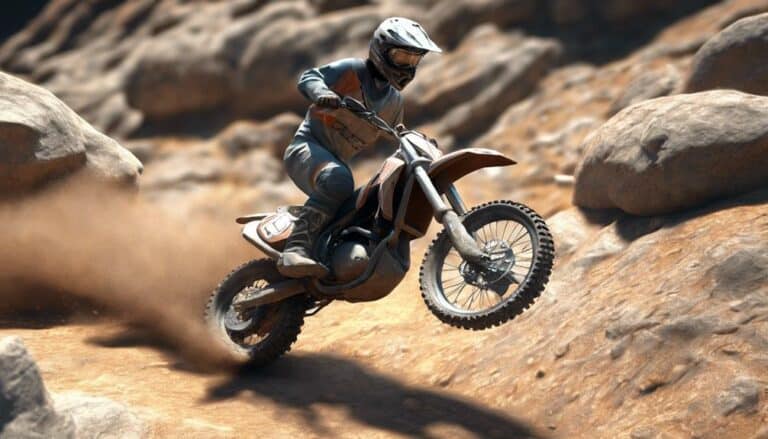When it comes to maneuvering your dirt bike off-road, remember that 'practice makes perfect.'
But how do you effectively modulate the front and rear brakes to navigate challenging terrains?
Properly balancing the use of both brakes is crucial, but there's more to it than just squeezing and releasing.
Understanding the subtleties of brake modulation can greatly impact your riding experience, enhancing both control and safety.
Stay tuned to discover the essential techniques that will elevate your off-road biking skills to the next level.
Key Takeaways
- Front brake for initial stopping power and control, rear brake for stability and balance
- Balancing front and rear brake application optimizes braking efficiency
- Adjust brake pressure based on terrain for optimal performance
- Smooth and progressive braking prevents skidding and enhances bike handling
Understanding the Basics of Braking
To master the art of braking effectively on a dirt bike, you must grasp the fundamental principles that govern the use of front and rear brakes in off-road scenarios. The front brake provides initial stopping power and precise control, essential for guiding unpredictable terrains.
On the other hand, the rear brake aids in stability, prevents skidding, and assists in maneuvering tight turns. Achieving a balance between front and rear brake application is key to optimizing braking efficiency while maintaining traction on various off-road surfaces.
Smooth and progressive braking techniques are essential to avoid skidding and retain control over the dirt bike. It's imperative to adapt your braking strategy based on the terrain you're riding on, adjusting the distribution of front and rear brake usage to enhance performance off-road.
Importance of Front Brake Control
Mastering the control of your front brake is essential for achieving maximum stopping power and stability when tackling challenging off-road terrains. The front brake on your dirt bike plays an important role in providing the majority of your stopping power, especially in abrupt situations.
Effective modulation of the front brake is key to maintaining control and stability. By skillfully controlling the front brake, you can prevent front wheel skidding, which is important for enhancing your overall bike handling abilities. When moving through tight turns and off-camber sections off-road, proper front brake control becomes even more critical.
It's through mastering front brake modulation that you achieve balanced braking, optimizing traction and control on varying surfaces. Remember, the front brake isn't just for stopping; it's a tool that, when used skillfully, can enhance your off-road biking experience by improving your overall control and stability.
Applying Rear Brake Techniques
When traversing challenging off-road terrains, seamlessly integrating rear brake techniques into your riding approach enhances your control and speed management. The rear brake plays a critical role in off-road riding, primarily used for controlling speed and maintaining balance.
To effectively utilize the rear brake, apply gradual pressure on the rear brake lever to prevent rear wheel lock-up and skidding, especially on loose terrain. Adjust the rear brake pressure according to the terrain's grip level to avoid losing traction and guarantee stability.
When moving through dirt trails, combine the rear brake with the front brake for smooth and controlled braking. Practice feathering the rear brake, a technique where you lightly apply and release the brake to modulate speed efficiently in challenging off-road conditions.
Mastering Braking on Different Terrain
Adjust your brake modulation technique according to the specific terrain conditions you encounter, such as mud, gravel, or sand, to optimize control and stability while riding off-road.
- Front Brake Bias: On loose or slippery terrain like mud or sand, rely more on the front brake to prevent rear wheel lock-up and maintain steering control.
- Rear Brake Control: In gravel or rocky areas, use the rear brake judiciously to avoid skidding and maintain traction for better stability.
- Smooth Braking: Practice smooth and progressive braking inputs to adapt to the varying grip levels of different terrains encountered off-road.
- Weight Transfer: Understand the weight bias during braking on different surfaces; adjust your technique to control the bike effectively and prevent loss of stability.
Advanced Tips for Brake Modulation
Utilize a balanced application of both front and rear brakes to enhance your control and stability when tackling challenging off-road terrain. To master brake modulation, consider a 60/40 split between the rear and front brakes. Initiate braking with the rear brake first, then smoothly apply the front brake to prevent skidding and maintain traction. Adjust your brake pressure according to the terrain to effectively modulate stopping power and guarantee consistent control.
When traversing off-road conditions, it's critical to employ smooth and progressive braking techniques. Abrupt stops can lead to loss of control, so develop muscle memory for sequential braking to enhance your handling on varied surfaces. By practicing these advanced tips, you'll not only improve your braking skills but also increase your overall confidence and performance on challenging off-road trails. Remember, mastering brake modulation is essential for optimizing your bike's control and your safety while riding off-road.
Conclusion
Now that you have mastered the art of modulating front and rear brakes on your dirt bike off-road, it's time to put your skills to the test.
Explore different terrains, push your limits, and see the theory in action. Only by challenging yourself and experimenting with various techniques will you truly understand the power of brake modulation in enhancing your control and performance on the trails.
Keep pushing boundaries and ride on!

